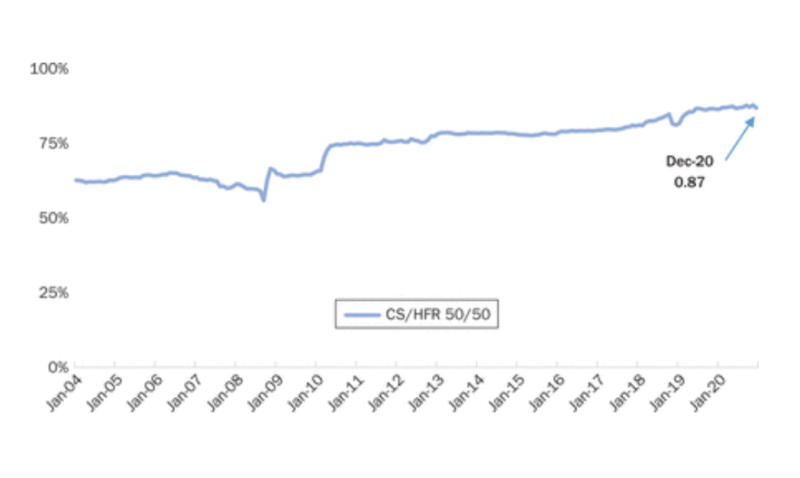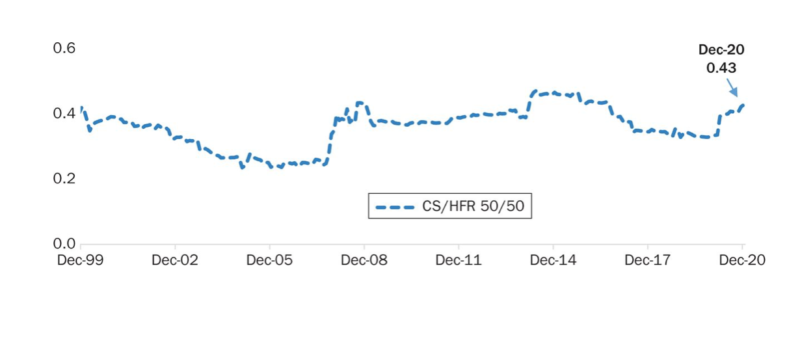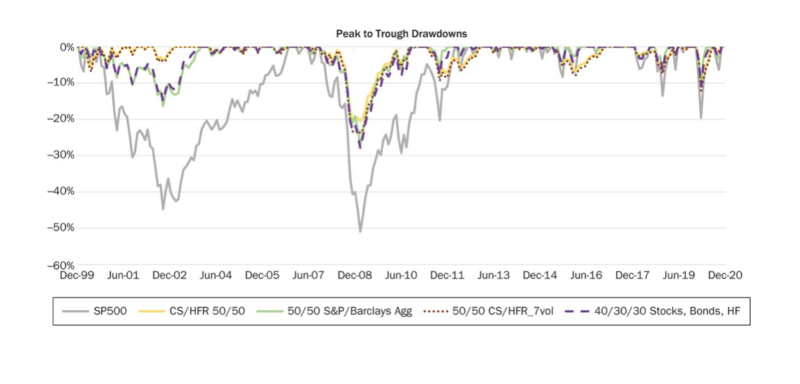
By LARRY SWEDROE
The history of the hedge fund industry is an interesting one. 25 years ago, approximately $300 billion of assets were invested in them. Today that figure has increased to more than $5 trillion. The increase was fuelled by the strong returns and the diversification benefits provided by hedge funds in the 1990s. For example, in his mini book Skating Where the Puck Was, William Bernstein examined the returns of hedge funds, applying a three-factor analysis to the Hedge Fund Research global returns series, and found that over the period 1998-2002, hedge funds produced an incredible alpha of 9.0 percent. Unfortunately for investors, the news has been all downhill from there.
Disappearing alpha
Rodney Sullivan’s study, Hedge Fund Alpha: Cycle or Sunset?, published in the Winter 2021 issue of The Journal of Alternative Investments, examined the performance of hedge funds over the period 1994-2019 and found that while over the whole period the average hedge fund alpha was 1.7 percent, it has been declining sharply — beginning in 2009, the annual alpha was -1.0 percent, down from 3.4 percent in the earlier period. The impact on investors was much worse than it appears because the early strong results led to increased cash flows. When Sullivan asset-weighted the returns, he found that hedge funds had destroyed almost $46 billion. Similar results were found by Nicolas Bollen, Juha Joenväärä and Mikko Kauppila, authors of the study Hedge Fund Performance: End of an Era?, published in the Financial Analysts Journal, Issue 3 (2021).
We now turn to examining the issue of hedge funds providing diversification benefits by accessing unique sources of risk.
Diversification benefits
Rodney Sullivan’s earlier work led him to take another look at hedge fund performance. While hedge funds have been producing negative alphas, perhaps they are providing strong diversification benefits. His paper, Hedge Fund Alpha: What about Drawdowns?, was published in the Fall 2021 issue of The Journal of Alternative Investments. Here again, the news for investors was not good, as Sullivan found that the correlation of returns between hedge funds and the S&P 500 Index had significantly increased. The following chart shows the 10-year trailing correlation of hedge fund returns versus the S&P 500. The composite uses the monthly after-fee returns of the overall Barclay Hedge Fund Index and the HFRI Fund Weighted Composite Index (weighted 50/50).

As you can see, there has been a persistent trend of correlations, gradually increasing from around 65 percent in the early period to 75 percent following the global financial crisis and 87 percent by December 2020.
Another problem for hedge funds is that in his aforementioned study Hedge Fund Alpha: Cycle or Sunset?, Sullivan had found that hedge fund returns were well explained by their exposures to the leading common factors used in asset pricing models: beta, size, value, cross-sectional momentum, quality, time-series momentum (trend following) and equity volatility (selling both a put and a call with the same strike price). These factors were able to explain almost 90 percent of the variation in returns in the post-global financial crisis era — there was not much unique risk in hedge funds.
While correlations are helpful in understanding how hedge fund returns move relative to stocks across time and differing market environments, correlations don’t tell us about the magnitude that hedge funds move relative to stocks, or their overall volatility, compared to that of the market. We also want to know their systematic exposure to equity risks—their betas. As you can see in the following chart showing the five-year trailing hedge fund beta versus the S&P 500, Sullivan found that hedge fund beta drifted over the years, from a low of around 0.20 in the early 2000s to a high of approximately 0.50 in 2006, and ended the period in December 2020 at 0.43.

We should expect that betas below 1 should provide some downside protection against equity bear markets. However, investors can achieve the same objective by simply lowering their portfolio’s exposure to beta and increasing their exposures to the other factors that explain most of hedge fund performance. In other words, you don’t have to pay 2%/20% for a bear market hedge. The following chart shows the downside risks of various portfolios:

As you can see, Sullivan found that hedge funds did provide some significant downside hedging benefits in the 2000-02 period. However, the benefits virtually disappeared in the 2008-09 bear market and the COVID-19 crisis of early 2020, when all four composite portfolios fell about 10 percent.
The bottom line is that hedge funds have been generating negative alphas for well over a decade while providing decreasing hedging benefits from diversification and drawdowns. Perhaps we are witnessing the end of an era.
Explaining the deterioration in performance
In our 2020 book, The Incredible Shrinking Alpha, Andrew Berkin and I provided four explanatory factors for the deterioration in hedge fund performance — factors that also explain the deterioration in the performance of active managers in general:
- Academic research has been converting what was once alpha into beta.
- The pool of victims that can be exploited has been shrinking, as individual investors directly own a shrinking share of public equities.
- The competition has been getting tougher — today’s active managers are far more skilled and have far greater resources.
- The supply of dollars chasing alpha has increased.
The empirical research findings we have reviewed create a puzzle. Why have hedge fund assets continued to grow? Why have investors ignored the evidence? Perhaps they are unaware. Another possible explanation is the all-too-human need to feel part of “the club” that has access to these funds. Those investors would have been better served to follow Groucho Marx’s advice: “I wouldn’t want to belong to a club that would have me as a member.”
Important Disclosure: The information contained in this article is for educational purposes only and should not be construed as specific investment, accounting, legal or tax advice. The analysis contained in this article is based upon third party information available at the time which may become outdated or otherwise superseded at any time without notice. Indices are not available for direct investment. Their performance does not reflect the expenses associated with the management of an actual portfolio nor do indices represent results of actual trading. Information from sources deemed reliable, but its accuracy cannot be guaranteed. Third-party information is deemed to be reliable, but its accuracy and completeness cannot be guaranteed. By clicking on any of the links above, you acknowledge that they are solely for your convenience, and do not necessarily imply any affiliations, sponsorships, endorsements or representations whatsoever by us regarding third-party websites. We are not responsible for the content, availability or privacy policies of these sites, and shall not be responsible or liable for any information, opinions, advice, products or services available on or through them. Neither the Securities and Exchange Commission (SEC) nor any other federal or state agency have approved, confirmed the accuracy, or determined the adequacy of this article. The opinions expressed by featured authors are their own and may not accurately reflect those of the Buckingham Strategic Wealth®, Buckingham Strategic Partners® (collectively Buckingham Wealth Partners). LSR-21-174
LARRY SWEDROE is Chief Research Officer at Buckingham Strategic Wealth and the author of numerous books on investing.
ALSO BY LARRY SWEDROE
How will the rise of ESG affect stock returns?
Do capture ratios actually tell us anything?
Private debt funds: how have they performed?
OUR SISTER BLOGS
If you’re a financial adviser or planner and you enjoy TEBI’s articles, why not try our sister blogs, Adviser 2.0 and Evidence-Based Advisers?
© The Evidence-Based Investor MMXXI









